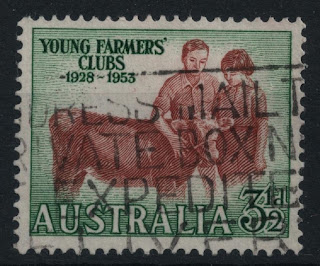For
some months now I have been busy looking through hundreds of the Australia 1953
Produce Food 3½d Scarlet Butter stamp trying to find all of the different types
of the “Retouch Beneath Milking Cup on Cow” variety. Well, I have some good
news on that front. I have now managed to find an example of all types. There
are 12 types in total, and I am going to share them all with you today in this
blog.
This
stamp was released on 11th February 1953 as part of the Produce Food series.
This set was issued to draw attention to the Australian Campaign to increase
food production to meet overseas requirements. These stamps were distinguished
for being the first new design to be printed by Letterpress in 20 years.
The
series incorporated three designs, each featuring a different type of
Australian produce. Wheat. Beef. Butter. The series was designed and engraved
by George Lissenden, and was Rotary recessed-printed on Unwatermarked paper.
The stamps are perforated 14.50 x 14.65.
The series was printed in sheets of 50 in a se-tenant arrangement of the
three designs. This means that the Butter and Wheat stamps appeared 17 times on
the sheet, and the Beef stamp appeared 16 times. It is also worth noting that
the three stamp sequence changed on each row. The total number of Butter and
Wheat stamps printed was 19,549,830 and the Beef stamp was printed 18,399,840
times (2015 Australian Commonwealth
Specialists' Catalogue for Queen Elizabeth II 1952-1966, page 8/28-32).
Type
I
Type II
Type III
Type IV
Type V
Type VI
Type VII
Type VIII
Type IX
Type X
Type XI
Type XII
Until my next blog.
Happy Stamping!






































